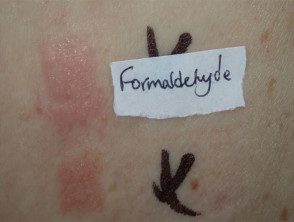What is formaldehyde and where is it found?
Formaldehyde is a chemical that is widely used in many products in our environment. It would be difficult to list all the possible sources of formaldehyde; The following table shows some of the most common sources of formaldehyde exposure.
| Sources of formaldehyde |
|
What are the reactions to formaldehyde?
Reactions to formaldehyde depend on the type of exposure that has occurred. Formaldehyde is not only a sensitizer but also a potent primary irritating. Exposure to formaldehyde gas can cause burning sensations in the eyes, nose and throat, rashes, chest tightness and wheezing, fatigue and headaches. These symptoms may be the result of a primary irritant effect or an allergy. sensitization to formaldehyde
Frequent or prolonged exposure may cause hypersensitivity, leading to the development of allergic contact dermatitis. Formaldehyde was declared contact Allergens of the year 2015 by the American Contact Dermatitis Society (ACDS).
Allergy Formaldehyde can occur through skin products that contain formaldehyde or with clothing made from fabrics that contain formaldehyde. Dermatitis caused by clothing tends to affect the parts of the body where there is the most friction between the skin and the fabric, for example, “trouser dermatitis” usually appears on the inner thighs. gluteus folds and back of the knees. Sweating can also be a factor that causes allergic dermatitis such as sweat or tallow appears to leach free formaldehyde from formaldehyde resins. Formaldehyde-sensitive people are not necessarily hypersensitive to formaldehyde resins. Clothing dermatitis is reported to affect women more than men.
In very sensitive people, contact with small amounts of formaldehyde, or being in a room where a bottle of formaldehyde may have been previously opened, leaving residual gases, can cause dermatitis.

Patch tests
Am I allergic to formaldehyde?
Formaldehyde allergy is diagnosed based on clinical history and by performing patch tests
Formalin patch test (40% solution of gaseous formaldehyde) is carried out using an aqueous solution of formalin at 2%. Some researchers have stated that the 75% of positive patch tests have no clinical significance and only the 20% of these may be related to real cases of formaldehyde dermatitis.
The diagnosis of clothing dermatitis due to free formaldehyde can only be confirmed if the following standard criteria are met. In some cases, clothing dermatitis may not be a problem, even if the suspected fabric tests positive for free formaldehyde and an individual has a positive patch test reaction to formalin 2%.
| Dermatitis in formaldehyde clothing: criteria to meet |
|
Product patch testing for formaldehyde resins is performed using 10% of urea formaldehyde in Vaseline, 10% of melamine formaldehyde in Vaseline, and 1% of other formaldehyde resins in Vaseline or isopropyl alcohol.
A product self-test for formaldehyde should be performed only with products designed to remain on the skin, such as cosmetics and lotions. Apply a small amount of the product to a small sensitive area of skin, such as the crook of your arm or neck. Examine the area every day for several days and if no reaction occurs, the product is likely suitable for use.
Treatment of contact dermatitis due to exposure to formaldehyde
If you are diagnosed with a formaldehyde allergy, if possible, avoid exposure to products containing formaldehyde; otherwise, take steps to reduce potential exposure.
Once dermatitis appears on the skin, treatment is like any other. acute dermatitis/eczemathat is to say current corticosteroids emollients, treatment of any secondary bacterial infection (Staphylococcus aureus), etc.
What should I do to avoid formaldehyde allergy?
It is difficult to avoid all exposure to formaldehyde because it is normally present at low levels (usually <0.03 ppm) tanto en aire interior como exterior. Para la mayoría de las personas, la exposición a bajo nivel (hasta 0.1 ppm) no causa ningún problema. Los métodos para evitar o minimizar la exposición se describen en la tabla a continuación.
| Methods to avoid or minimize exposure to high levels of formaldehyde |
|
Alternative names for formaldehyde
Formaldehyde is also known by several other names. These include:
- Formalin
- Metanal
- methyl aldehyde
- methylene oxide
- morbicidal acid
- Oxymethylene
Avoid all this. At work, request a material safety data sheet to help identify potential sources of exposure.
More information
Formula: CH20 0
CAS number: 50-00-0
Cross reactions: possibly glutaraldehyde
Appearance: clear, colorless liquid
Sensitizer formaldehyde free, formaldehyde resins
Patch test:
2% aqueous solution of formalin (40% solution of formaldehyde gas)
10% Urea Formaldehyde in Vaseline
10% Melamine Formaldehyde in Vaseline
1% of other formaldehyde resins in petroleum jelly or isopropyl alcohol.
| Sources of exposure to formaldehyde | ||
|---|---|---|
|
|
|
